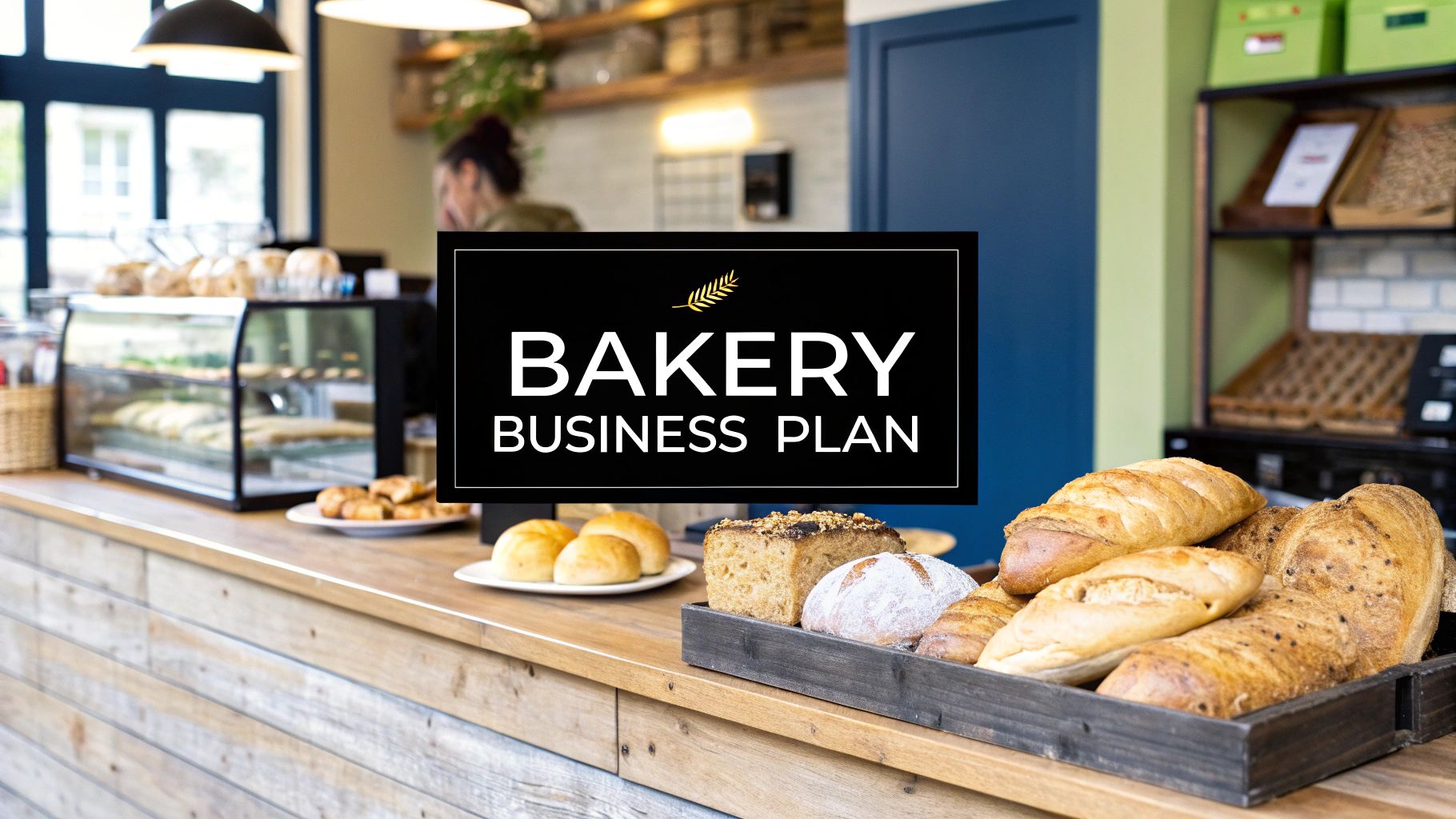Your passion for baking is the heart of your business, but a solid bakery business plan template is the backbone that will support its growth. For a small entrepreneur, this isn't just corporate paperwork; it's the recipe for your success—a detailed guide that covers everything from your unique sourdough starter to your five-year financial goals.
Crafting Your Small Bakery's Winning Blueprint
Let's be honest, starting a bakery is about so much more than having a killer chocolate chip cookie recipe. To turn that dream into a profitable small business, you need a meticulously crafted business plan. This document is the blueprint that will guide every decision you make, from launch day to your first expansion.
This guide is designed to help you, the small business owner, create a plan that genuinely captures your vision. A great business plan tells a compelling story about your brand and convinces lenders—and yourself—that you have what it takes to succeed as an entrepreneur.
First things first, you need to nail down your core business model. What kind of bakery are you building?
- Retail Storefront: Are you picturing a cozy neighborhood spot where you build a community, one customer at a time?
- Wholesale Supplier: Is your dream to be the engine behind local cafes, supplying them with your signature croissants and muffins?
- Online or E-commerce: Will you run a lean operation from a commercial kitchen, shipping your treats directly to customers who order online?
- Hybrid Model: Or will you mix and match, running a small storefront while also handling online orders and a few key wholesale accounts to diversify your income?
Each of these business models has completely different startup costs, marketing plans, and operational challenges. Deciding on your approach early on is the first real step to building a plan that makes sense for a small entrepreneur.
Understanding Your Key Financial Milestones
Getting a handle on your numbers from day one is critical for any small business. You need to ground your plan in financial reality. This snapshot gives you a quick look at the kind of metrics a small bakery startup might be working with.
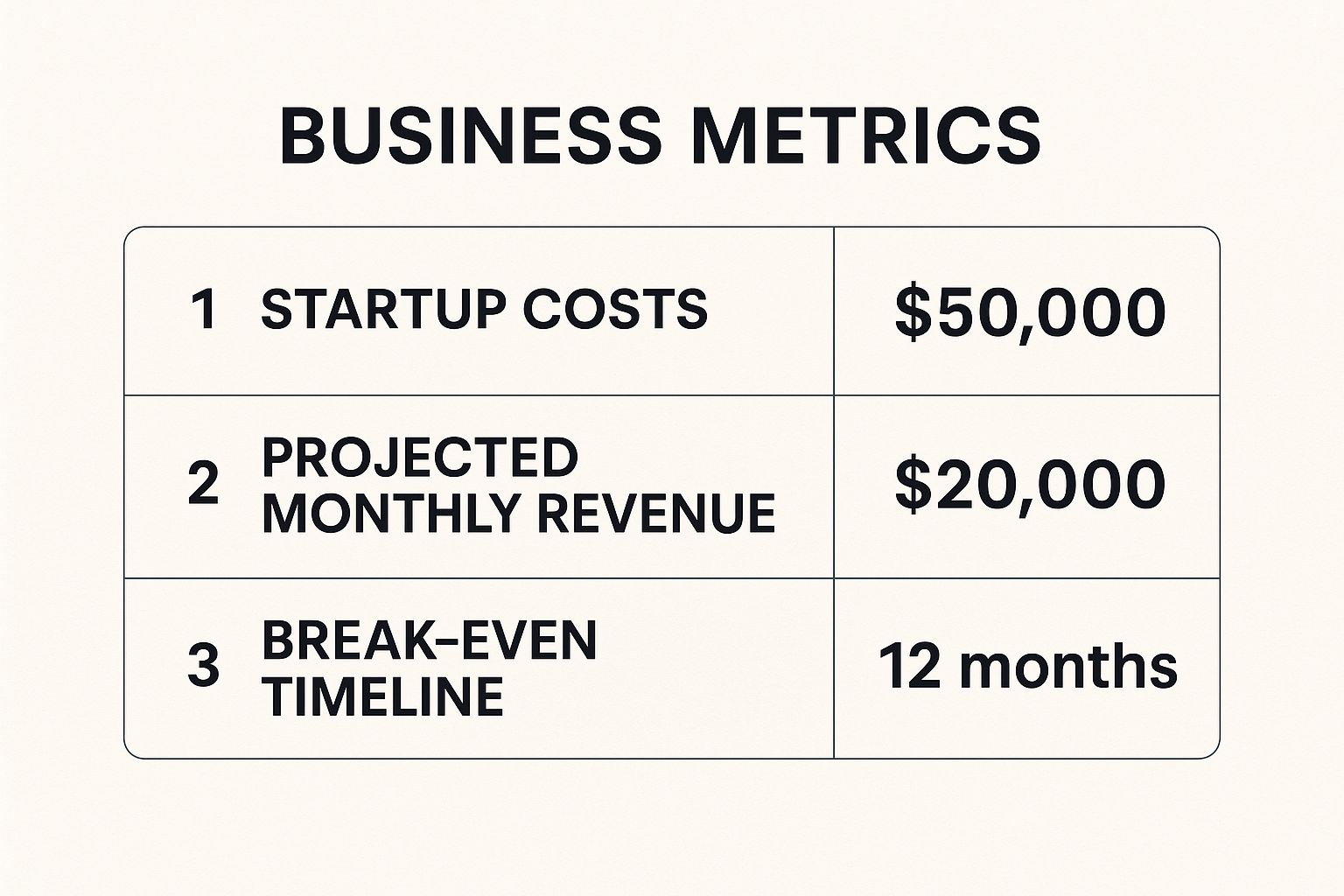
These numbers show the delicate balance between your initial investment and the revenue you'll need to generate to stay afloat and eventually thrive. To see how these figures fit into a complete document, checking out a few https://growth-grid.ai/samples/bakery can be incredibly helpful.
A strong business plan doesn't just predict the future; it creates it. By setting clear goals and outlining actionable steps, you transform your entrepreneurial dream into a tangible and achievable reality.
Remember, this plan is your number one tool for talking to investors, partners, and lenders. A well-researched, thoughtful business plan shows them you've done your homework and you’re serious about building a lasting small business. If you want to dive deeper into creating a document that can really wow potential backers, this guide on how to write a comprehensive business plan is an excellent resource for any food entrepreneur.
Defining Your Bakery's Core Mission
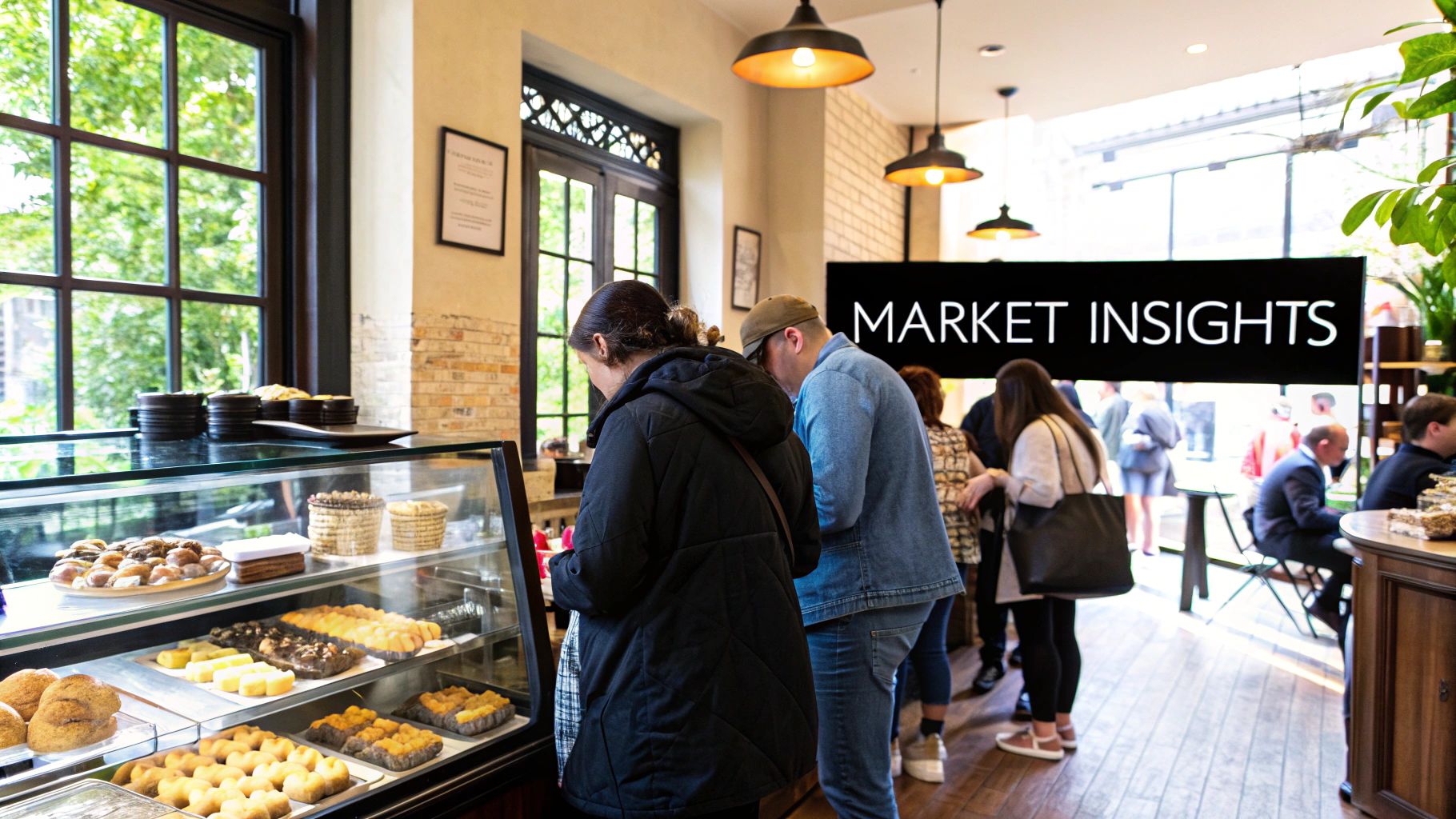
This is where the heart and soul of your small business comes to life on paper. The executive summary in your bakery business plan template isn't just an introduction; it’s the very first impression you'll make on a potential lender, partner, or investor. It has to be compelling and clear, capturing the essence of what you're trying to build.
Think of it as the elevator pitch for your entrepreneurial dream. In just a few paragraphs, it needs to lay out your mission, explain what makes your bakery different, and hint at your core values. This is your chance to answer the big question: Why does the world need another bakery, and why is yours the one that will succeed?
A powerful mission statement becomes your North Star, guiding every decision you make as a small business owner, from what’s on the menu to how you draft your marketing plan.
Articulating Your Unique Selling Proposition
Your Unique Selling Proposition (USP) is the single most important part of your executive summary. It’s the specific, concrete promise you’re making to your customers—the one thing they can only get from you. You need to ask yourself a tough question: what will my small bakery be famous for?
Maybe you're the only one in town using 100% locally-milled, organic flour from a farm down the road. Or perhaps you've perfected allergen-free celebration cakes for a community that has no other options.
Let's imagine a couple of small bakery business models to see how this works:
- "The Flour Mill Bakery" might build its USP around tradition. Their mission could be: "To craft artisanal breads and pastries using time-honored techniques and ingredients sourced directly from Hudson Valley farms, reconnecting our community with wholesome, handcrafted food."
- "Safe & Sweet Treats" could focus on a specific dietary need. Their mission might be: "To provide delicious, joyful, and completely gluten-free and nut-free baked goods, ensuring everyone can safely celebrate life's special moments without compromise."
See how a clear USP immediately shapes the entire business? It tells people what you stand for. This kind of clarity is exactly what investors are looking for in a solid business plan.
Expert Tip for Entrepreneurs: Write your executive summary last, even though it sits at the front of your business plan. After you’ve wrestled with your market analysis, operational details, and financial projections, you'll have the clarity you need to nail this section.
Choosing the Right Business Model
Once you know why you're starting this bakery, you have to figure out how it's going to work. Your business model is the blueprint for how you'll operate, make money, and hopefully, grow. For any new bakery owner or small entrepreneur, this is a huge decision that will impact your startup costs, daily routine, and long-term potential.
Every model has its own upsides and headaches. The key is to pick the one that fits your financial situation, your personal strengths, and the specific opportunity you've spotted in the market.
Here’s a look at the most common business models for small bakeries:
| Business Model | Pros | Cons |
|---|---|---|
| Retail Storefront | You get to interact directly with customers, build a strong community presence, and have high brand visibility. | Overhead is a killer (rent, staff, utilities). Success often depends on snagging a prime location. |
| Wholesale Supplier | Sales can be high-volume and predictable. Operations are often simpler without a retail front. | Profit margins are much lower. You’re totally reliant on your relationships with other businesses. |
| E-commerce / Online | Startup costs are significantly lower, your reach isn't limited by geography, and you have more flexibility. | Driving traffic costs money and time. Shipping and logistics can be a nightmare. You miss out on foot traffic. |
| Hybrid Model | You can diversify your income streams, balancing the brand-building of retail with the stability of wholesale. | Juggling both can get really complex. It requires expertise in retail, logistics, and B2B sales. |
Whichever business model you land on, you need to spell it out clearly in your business plan. Don't just say you're doing a hybrid model. Get specific. For instance: "We will operate a small retail storefront to build a local brand and capture high-margin sales, while dedicating 40% of production to wholesale contracts with three local coffee shops to ensure consistent baseline revenue." That kind of detail proves you've done your homework.
Digging into Your Market and Carving Out Your Niche
Before you even think about dusting off your mixer, you have to get a rock-solid understanding of the market you’re about to enter. A deep market analysis isn't just some section to fill out in your bakery business plan template—it's the bedrock of your entire small business. This is where you figure out who you’re baking for, what makes them tick, and how you can give it to them better than anyone else.
Honestly, knowing the local landscape is non-negotiable for a small entrepreneur. It’s how you turn a passion for baking into a business that actually works. You need to ask yourself the tough questions now. Who are these people I want to sell to? What are their daily habits, their secret cravings, and how much are they willing to spend?
Pinpointing Your Ideal Customer
You can't be everything to everyone, especially when you're a small business just starting out. Trying to please the whole town is one of the fastest ways to burn through your cash and your passion. What you need is a laser focus on your ideal customer. Think of it as creating a detailed sketch of the person who will not only buy from you once but will become a loyal regular.
Picture the people in your community. Who are you really trying to attract?
- The Morning Rush Crowd: These are the busy professionals who need a fantastic coffee and a perfect croissant on their way to the office. For them, it's all about speed, convenience, and a little taste of luxury to start their day right.
- The Celebration Planners: Think parents organizing birthday parties or families looking for a special weekend treat. They’re looking for creative custom cakes, cupcakes for school events, and a bakery they can rely on for those big moments.
- The Health-Minded Eaters: This group is actively seeking out gluten-free, vegan, or keto-friendly options. They read labels, care about where ingredients come from, and will pay more for treats that fit their lifestyle.
When you create these "personas," you suddenly have a guide for almost every decision you make in your marketing plan. Your menu, your pricing, the vibe of your shop, even the words you use on social media—it all gets easier because you know exactly who you're talking to.
Scoping Out the Competition to Find Your Opening
Alright, now it’s time to put on your detective hat. The point here isn't to copy what everyone else is doing, but to find a unique angle for your own small bakery. You need to go visit every single bakery, coffee shop, and even the grocery store bakery sections in your area.
And I don't mean just a quick peek in the window. Go in, buy something, and soak it all in.
- What’s their bestseller? What are they known for?
- How are they priced? Are they a budget-friendly spot or a high-end treat?
- What does it feel like to be a customer there? Is it a quick in-and-out transaction, or a cozy place where you want to hang out?
- Most importantly, where are they falling short? Maybe their coffee is mediocre, their vegan selection is pathetic, or their staff seems completely uninspired.
My favorite piece of advice for small entrepreneurs: Look for their weaknesses. Every single one is a golden opportunity for you. If nobody in your town is making truly killer sourdough bread or offering decadent vegan pastries that don't taste like cardboard, you've just found a gap in the market you can own.
This kind of hands-on research helps you figure out what will make your bakery the one people talk about. You’re hunting for that unmet need, that little empty space in the market that your small business is perfectly suited to fill.
Riding the Wave of Key Industry Trends
The world of baking doesn't stand still. Keeping a close eye on industry trends helps you build a business that will last, not one that's just chasing a fad. This is where a little data can go a long way in shaping a marketing plan that’s based on reality.
The growth we're seeing is huge, especially in specialty niches. The global bakery market was valued at around USD 513.17 billion in 2023 and is projected to climb to USD 919.9 billion by 2032. A huge driver of that growth is the specialty segment—we're talking organic, gluten-free, and artisanal products—which is expected to grow by another USD 15.87 billion by 2028. If you want to dive deeper, there are some great bakery marketing statistics out there.
What this tells me, and what it should tell you, is that people are more willing than ever to pay for quality, uniqueness, and products that align with their health goals. When you weave these trends into your business plan, it shows potential investors that you’re a smart, forward-thinking entrepreneur ready to grow.
Nailing Down Your Bakery's Operations and Management Plan
A show-stopping croissant recipe is one thing, but a well-oiled kitchen that can produce it consistently is what builds a small business. This part of your business plan gets into the nitty-gritty of how your bakery will actually run day-to-day. You'll cover the daily workflow, the team making it all happen, and the physical space where the magic happens. A solid operational plan shows investors and lenders that you’ve truly thought through the practicalities of turning flour and sugar into profit.
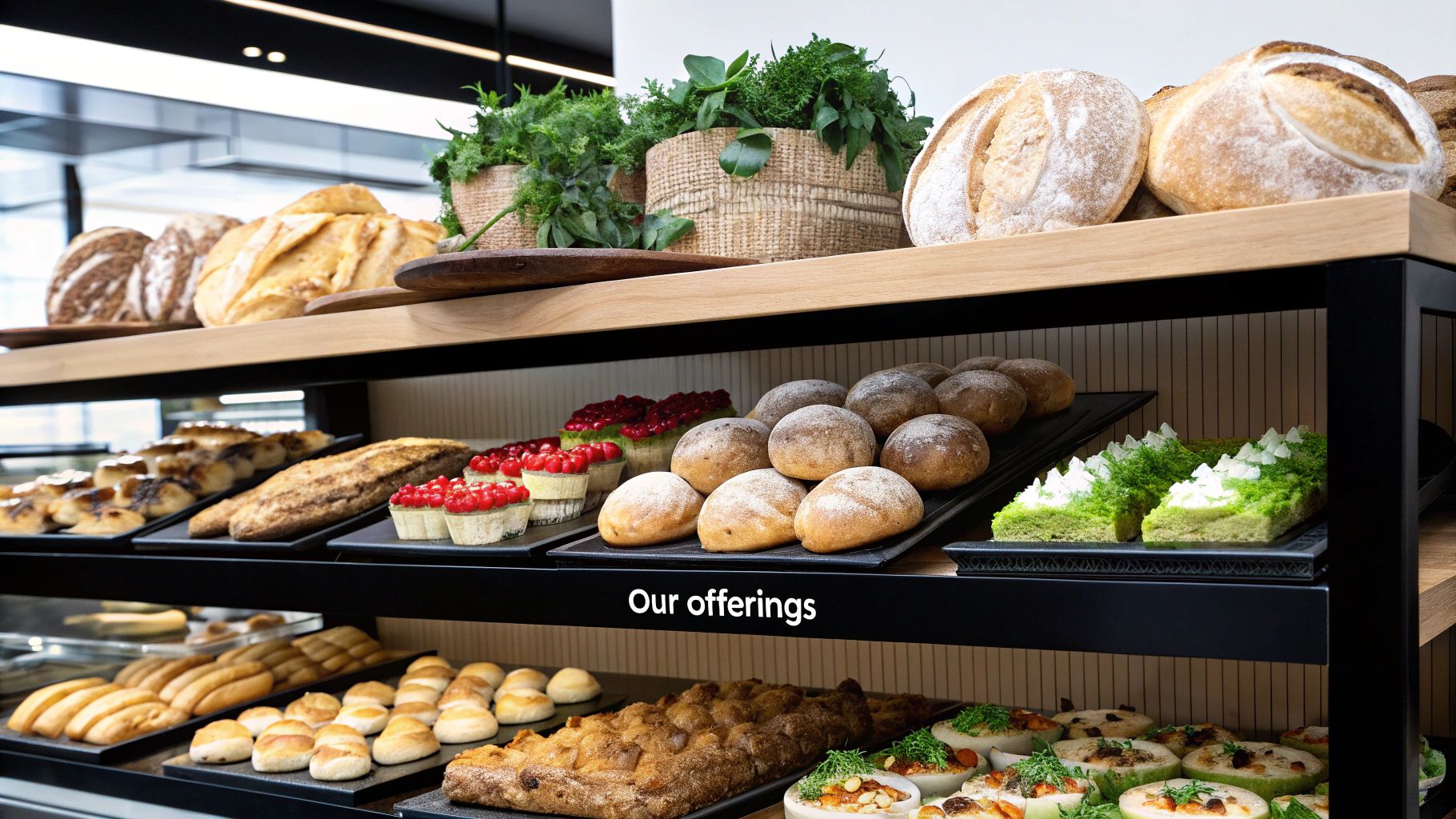
Think of this as your roadmap for the daily reality of being a small business owner. It's where your ideas meet execution, answering critical questions about where you'll set up shop, how the kitchen will function, and who’s going to do what.
Choosing a Location and Designing Your Space
Where you decide to open your doors is easily one of the biggest calls you'll make. A prime spot with tons of foot traffic can be its own marketing machine, but that visibility comes with a hefty price tag. On the flip side, a lower-cost location tucked away on a side street means your marketing plan has to work that much harder to bring people in.
Once you’ve found your spot, the layout of your kitchen and customer area is everything. A smart, efficient design minimizes wasted steps, speeds up production, and keeps stress levels down during the morning rush. You need to map out the entire flow, from where you store your 50-pound bags of flour to the prep stations, the ovens, and finally, the display case.
A few design points you can't overlook as a small business owner:
- Production Workflow: Literally walk through the process. Trace the journey of a single croissant from raw ingredients to the customer's bag. Does the path make logical sense, or are you crisscrossing the kitchen?
- Health Code Compliance: Before you build a single wall, get familiar with your local health department's rulebook. Make sure your design includes all the required sinks, ventilation, and storage from the very beginning.
- Customer Experience: If you have a retail storefront, the front-of-house needs to be more than just a place to pay. It should feel warm and welcoming, smell incredible, and showcase your beautiful products in the best possible light.
Sourcing Your Ingredients and Building Supplier Relationships
The quality of your butter, flour, and chocolate directly dictates the quality of what you sell. This isn't the place for a small entrepreneur to cut corners. Building strong, reliable relationships with your suppliers is absolutely crucial for consistency and managing your costs. Don't just chase the lowest price—find partners who deliver high-quality ingredients on time, every single time.
This has become even more important as people’s tastes change. The global market for bakery ingredients is expected to balloon from USD 23.67 billion in 2025 to USD 48.79 billion by 2035. This isn't just about more flour; it's about a growing hunger for specialty, local, and sustainable ingredients. Smart sourcing is a real competitive advantage.
Your suppliers are more than just vendors; they are partners in your success. A good supplier can alert you to new products, offer better pricing on bulk orders, and provide a reliable supply chain even during shortages.
Assembling Your Team and Management Structure
Even if you’re starting out as a one-person show, you need to map out the management structure in your plan. This is a great exercise for an entrepreneur because it forces you to be honest about your own strengths and weaknesses. What can you realistically handle yourself, and where will you need to hire help as the business grows?
Your staffing plan should detail every single role needed to keep the bakery running smoothly. Walk yourself through a typical day, from unlocking the doors before sunrise to cashing out at night.
Key Roles You Might Need in a Small Bakery:
- Head Baker/Pastry Chef: The creative heart of the operation. They're in charge of product creation, quality control, and developing new recipes.
- Counter Staff/Barista: The face of your business. This person handles sales, answers questions, and makes a great cup of coffee to go with your pastries.
- Kitchen Assistant/Prep Cook: The indispensable right-hand to the baker. They help with everything from measuring ingredients and washing dishes to general kitchen prep.
- Delivery Driver: If you plan on doing wholesale accounts or offering direct-to-customer delivery, this role is a must.
Defining these roles and responsibilities from the get-go prevents confusion and makes sure everyone knows what's expected of them. A great way to formalize this is by creating an employee handbook. For some helpful guidance, check out our in-depth article on how to create an HR handbook. A well-defined team structure shows everyone that your bakery isn't just a passion project—it's a scalable, well-organized small business.
Building Your Small Business Marketing Plan
Let's be honest—your incredible croissants and perfectly iced cakes can't sell themselves if nobody knows you exist. A smart marketing and sales plan is the engine that drives people to your door, turns them into regulars, and ultimately, makes your small business a success. This is where you map out exactly how you'll make that happen.
It all starts with what you're selling. Your menu isn't just a list of items; it's your single most important marketing tool. From your signature bakes to your pricing, every detail needs to be intentional.
Designing a Menu That Sells
Think of your menu as a direct reflection of your brand and the ideal customer you identified earlier. If you're hoping to catch the morning commuter crowd, you need quick, grab-and-go items like savory scones and exceptional coffee. If custom wedding cakes are your passion, your menu should showcase incredible flavor pairings, design possibilities, and a dead-simple ordering process.
When you're putting it all together, focus on these key areas in your marketing plan:
- Core Offerings: These are your signature bakes—the things you want to be famous for. They should always be available and showcase the absolute best of what you do.
- Seasonal Specials: Limited-time offerings create a buzz and a reason for people to come back. Think pumpkin-chai muffins in the fall or strawberry-rhubarb pies in early summer. It keeps things fresh and exciting.
- Pricing Strategy: Don't just guess what to charge. You need to meticulously calculate your cost-per-item to ensure your prices cover ingredients, labor, and overhead while still feeling like a great value to your customers.
Crafting a Memorable Brand Identity
Your brand is so much more than a logo. It’s the entire feeling a customer gets from your bakery, from the moment they spot your shop on Instagram to the last bite of that cookie they just had to have. A strong brand makes you stand out and stick in people's minds.
Start by thinking about your bakery's personality. Is it cozy and traditional? Modern and minimalist? Whimsical and fun? This personality should shine through in everything—your shop's decor, your packaging, the voice you use on social media, and how your team greets every person who walks in.
A great brand tells a story. For a small bakery, that story might be about family recipes passed down for generations, a fierce commitment to local ingredients, or a passion for creating delicious allergen-free treats that everyone can enjoy.
Budget-Friendly Marketing Tactics for Small Entrepreneurs
You don't need a huge budget to make a real impact. For a new small business, it’s about being smart and focused, not trying to do everything at once. Your main goal is to build a community.
Here are a few practical, low-cost marketing plan ideas that actually work:
- Be Visual on Social Media: Platforms like Instagram are a bakery's best friend. Post high-quality, drool-worthy photos and videos of your products every single day. Show behind-the-scenes glimpses, run fun polls, and introduce your team to engage your followers.
- Build an Email List: Offer a small incentive—like a free coffee on their next visit—for customers to sign up for your email list. This gives you a direct line to your most loyal fans to announce specials, share news, and offer exclusive deals.
- Master the In-Store Experience: The smell of fresh bread, a warm greeting, a beautiful pastry case—these are powerful marketing tools. Make your bakery a place people want to be.
- Partner with Other Local Businesses: Find a nearby coffee shop that doesn't sell pastries and offer to supply them. They get great local treats, and you get free promotion to their customers. It's a win-win for small entrepreneurs.
The Importance of a Strong Online Presence
Even for a classic brick-and-mortar shop, a solid online presence is non-negotiable. Today, people discover new places to try through Google searches and social media. Your digital storefront needs to be just as inviting as your physical one.
At a minimum, you need a simple, easy-to-navigate website with your menu, hours, and location.
This digital focus is only getting more important. The global bakery products market is set to grow by a staggering USD 270.9 billion between 2025 and 2029, a surge driven by more bakeries getting online. Integrating things like online ordering for pickup is crucial for capturing a piece of that growth. If you're interested in the data, you can read the full report on the bakery products market to learn more.
Projecting Your Bakery's Financial Future
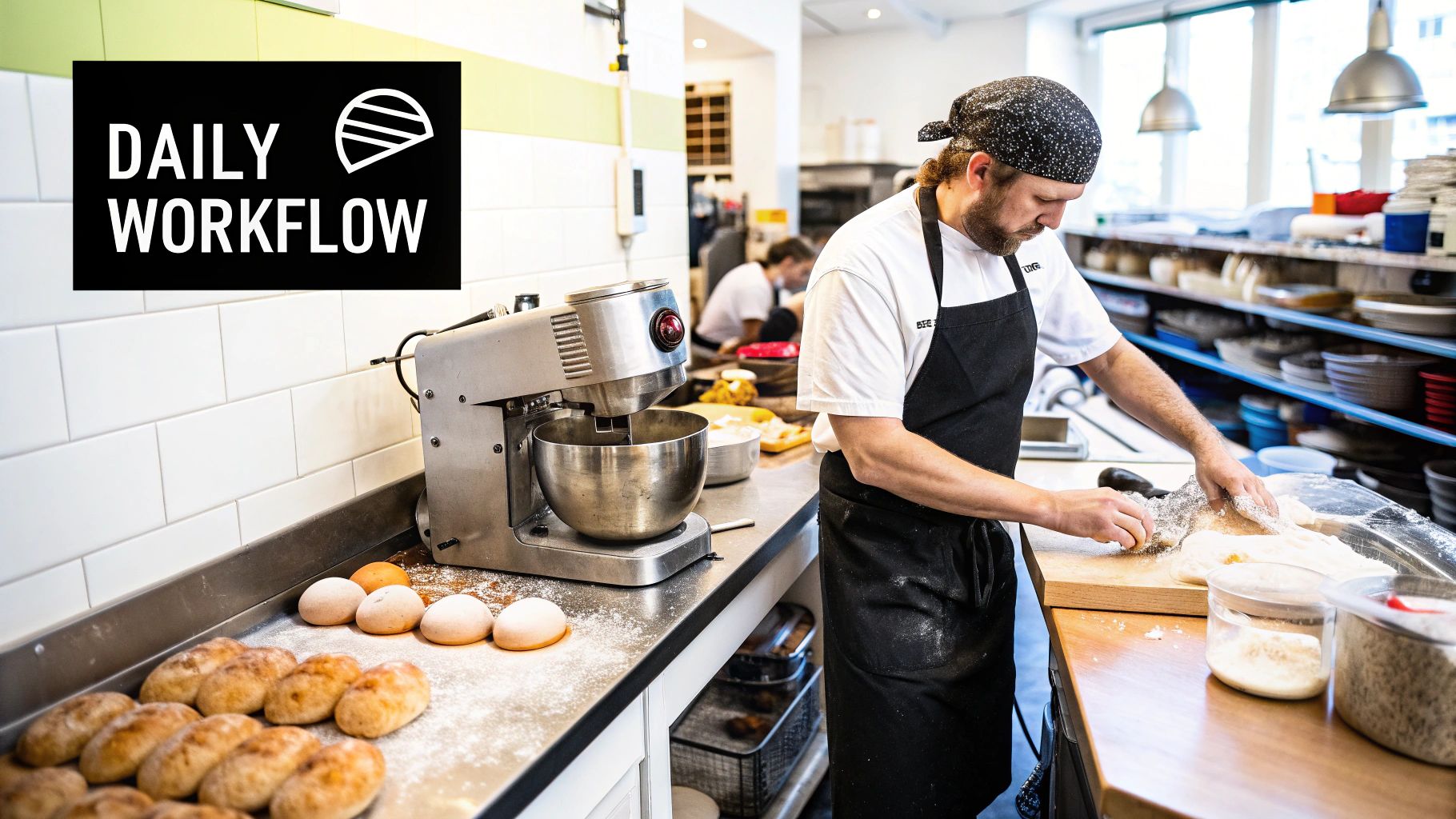
This is where your passion for baking meets the cold, hard numbers of running a business. Let’s be honest: the financial section of your bakery business plan template is what lenders and investors flip to first. It’s the part that translates your delicious vision into a language they understand—money.
A solid financial plan shows them your small business isn't just a dream; it's a viable venture ready to make a profit. We're going to break this down into simple, manageable pieces. This isn't about becoming a CPA overnight. It's about making smart, educated guesses based on real-world research to map out your first three to five years.
Calculating Your Startup Costs
Before a single croissant is sold, you have to spend money. The very first step for any entrepreneur is getting an accurate handle on startup costs—all the one-time expenses needed just to unlock the doors.
You need to think through every single item. It's easy to remember the big-ticket purchases like a commercial oven, but the small stuff can nickel-and-dime you into trouble if you're not careful.
Common Bakery Startup Expenses for a Small Business:
- Equipment: Think beyond the oven. This includes commercial mixers, proofing cabinets, prep tables, refrigerators, and those beautiful display cases.
- Initial Inventory: Your first massive shopping trip for flour, sugar, butter, yeast, and all your specialty ingredients.
- Licenses and Permits: Don't forget the paperwork! This covers health department permits, business licenses, and food handler certifications for your team.
- Leasehold Improvements: Your space probably isn't bakery-ready. You might need to install a three-compartment sink, proper flooring, or ventilation to meet health codes.
- Marketing and Grand Opening: Budget for your website, signage, some social media ads, and maybe a small launch event to create a buzz.
I've seen too many new entrepreneurs get into trouble by underestimating their initial costs. Here’s a pro tip: once you have your total, add a 15-20% contingency fund on top. Trust me, unexpected expenses will pop up.
Building Your Financial Projections
Once you know what it costs to open, it's time to map out how the business will actually perform. This means creating three core financial statements that show investors and lenders that your bakery can be profitable.
1. Sales Forecast: This is your best guess at how much you'll sell. Don't just pull numbers out of thin air. Base your forecast on your location's foot traffic, local market research, and your menu pricing. A smart way to do this is to project sales month-by-month for your first year, then switch to annual projections for years two and three.
2. Profit and Loss (P&L) Statement: The P&L is simple in concept: it subtracts all your expenses from your total revenue to show if you made a profit or took a loss. This includes both your Cost of Goods Sold (COGS)—the direct costs like flour and sugar—and your operating expenses, like rent, utilities, and payroll.
3. Break-Even Analysis: This is one of the most powerful numbers you'll calculate. Your break-even point is the exact amount of sales you need each month just to cover your costs. It's the moment you stop losing money. Knowing this figure is incredibly motivating and helps you set clear, achievable sales goals.
As you build these projections, you’ll also need to figure out where the money is coming from. Start exploring different small business funding options early on. The type of financing you secure can shape your entire financial plan.
And before you go all-in, it’s worth taking a step back to validate the whole idea. Our guide on conducting a https://growth-grid.ai/docs/feasibility-study can walk you through confirming your concept's viability. Ultimately, these financial documents are the final test, proving to yourself and any potential backers that your bakery has what it takes to succeed.
Common Questions for Small Bakery Entrepreneurs
When you're starting out, it feels like you have a million questions. Over the years, I've seen aspiring bakery owners wrestle with the same core uncertainties when putting their business plan together. Let's tackle a few of the big ones.
A question that comes up constantly is about the financials. Just how deep do you need to go in your business plan? You don't need a CPA certification, but your projections have to be rock-solid, especially for the first three years. Think through everything—the rising cost of flour, your packaging, software subscriptions, and even a buffer for potential rent hikes.
Then there's the question of length. People get really hung up on page count, but there's no magic number. A tight, focused business plan is always more impressive than a 100-page novel filled with fluff. Aim for 20 to 40 pages that pack a punch. It’s enough to give a lender the confidence they need without burying them in unnecessary detail.
How Much Money Do I Actually Need to Start?
This is the big one, isn't it? The true cost to get your small bakery off the ground. The honest answer is: it depends entirely on your business model. An online, direct-to-consumer cookie business will have a vastly different price tag than a brick-and-mortar cafe with seating.
To get a number you can trust, you have to get granular. List every single thing you can think of, from the big-ticket items like a commercial oven down to the small stuff like business cards and food handler's permits.
One of the biggest mistakes I see new entrepreneurs make is not building in a safety net. After you’ve calculated your total startup costs, add a 15-20% contingency fund on top. Trust me, unexpected expenses will pop up, and this buffer will be a lifesaver.
So what does this look like for a small business?
- A small retail shop in a decent location could easily run you $50,000 to $150,000 once you factor in equipment, lease deposits, and stocking your pantry for the first time.
- In contrast, a home-based operation selling at farmer's markets and online might get going for under $10,000.
Ready to turn your passion into a profitable plan? With GrowthGrid, you can generate a complete, professional bakery business plan in minutes. Stop guessing and start building your dream today. Get started with GrowthGrid now.
